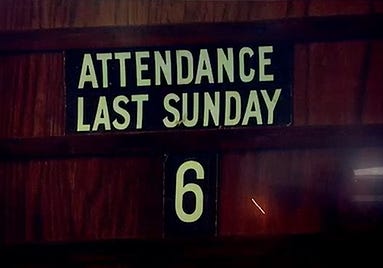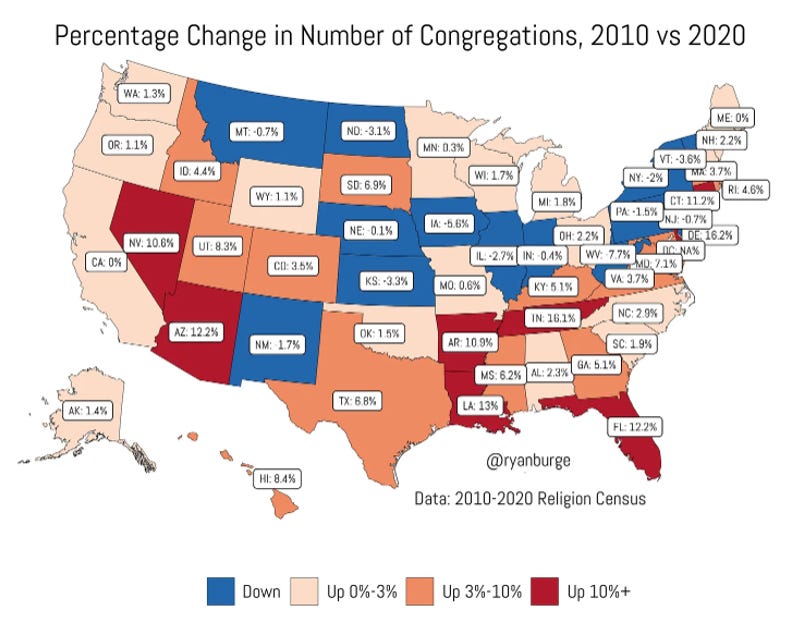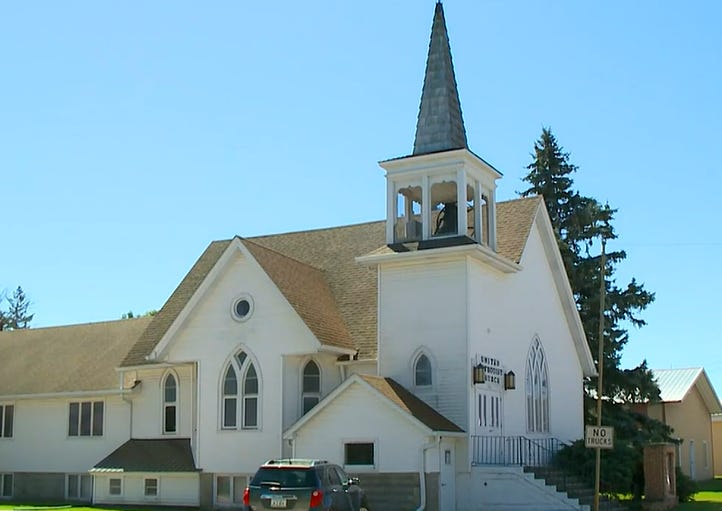Iowa is Becoming Less Religious
The Unintended Consequence of the Politicization of the Christian Faith
When I was born in Iowa in 1955, the percentage of Iowans who identified as Christian was 92%. I grew up attending church, as did most of my friends. It was just an expectation and obligation. I went to youth groups and church summer camps and became fully indoctrinated in evangelical Christianity. Billy Graham, who was idolized in my family, was considered the “pope” of the evangelical church and had an audience with Presidents from Eisenhower to Nixon…the cultural consensus was white-conservative-and Christian. I was all-in.
That is how I was raised in white-Christian Iowa. It was the status quo for which you never deviated or questioned.
But something has changed.
Iowans are becoming less religious. It may not seem so with Christian Nationalism running rampant in the Des Moines statehouse and governor’s mansion. Still, a new PEW research report called the Religious Landscape Study shows that Iowa has been hemorrhaging congregants and churches for the past 10 or 15 years faster than most of the nation.
We need to investigate why Iowans are becoming less religious despite the outsized influence of evangelicals in state politics and the impact it has, especially on rural communities that are losing churches. Perhaps a clue is to be found in the unintended consequence of the merger of white conservative Christianity with the MAGA movement.
The Story In the Data
PEW conducted the Religious Landscape study between 2007 and 2023-24. They surveyed more than 35,000 Americans in all 50 states about their religious affiliations, beliefs, and practices, along with their social and political views and demographic characteristics. That sample size allowed them to disaggregate the data to the state level with great confidence. You can find out more about the methodology of this study here, which is important if you are a data geek like me.
Analyzing and summarizing the data will help to show what is happening in the State of Iowa. Iowa is leading the exodus from religious faith and affiliation. The data is hard to deny. Using the national numbers as a baseline, we can compare Iowa to the nation. The story is revealing.
Take a look at this table from the study. I have added the difference column to identify the rate of change.
Here is the first observation that tells part of the story. When comparing all adults in the nation who identified as “Christian” in 2007 (78%) to those who did so in 2024 (62%), the difference was minus 16 points. This represents a national trend that has been happening everywhere since the 1990s.
When comparing those numbers to Iowa, what we see is a faster decline from 82% to 62% during the same period. Iowa saw a drop of 20 points. In other words, more Iowans are abandoning a Christian identity at a faster pace than in the nation. The result is that even though in 2007 more Iowans identified as “Christian” than the national average, by 2024, the percentage was the same: 62%.
When you begin to break these numbers down by Christian denomination, another story emerges. While Iowans chose to leave the evangelical and mainline Protestant churches at roughly the same rate as the nation, the category that jumps out is Catholic affiliation. It appears Iowa Catholic churches have borne the brunt of the exodus. While in the nation the Catholic Church experienced a 5-point drop in affiliation, in Iowa, the number was twice that…10 pts.
Why this is true in Iowa is not clear. It might be related to the ongoing scandal among Catholic clergy related to child sex abuse. Or it might be the church’s continuing patriarchal stance on women in leadership or same-sex marriage, despite the more liberalizing effect of Pope Francis. Whatever the reason, Iowa Catholics have been abandoning the ship at a faster pace than the rest of the country.
The Unaffiliated “Nones”
All Christian denominations are losing parishioners at various rates, but the number that should stand out is the “Unaffiliated.” It is the only category that is witnessing an increase in membership. And it is now the largest religious (or non-religious) group in the United States.
The “unaffiliated” category includes an eclectic group of people. There are atheists and agnostics, however, the largest are those who define themselves as “none of the above.” When it comes to those nosy questionnaires that ask you what your religious affiliation is, these folks respond, “none.” Therefore, they have come to be known to sociologists and other purveyors of religious demographics as the “nones.”
I count myself among this group and have been since 2006. After a 30-year affiliation with the “evangelical” wing of the Christian faith, I finally rejected all of it and became a “none.” (I didn’t know I was a “none” until many years later.)
There were many reasons for my departure from traditional evangelical Christianity, but one of them was the growing influence of right-wing politics within the evangelical church. Long before Trump became a reality, many people were choosing to turn away from the faith of their youth due to a growing politicization of the faith.
The main point is that the nones have been the fastest-growing group of Americans for the past 20 years or more. People by the millions have been abandoning their religious affiliation in search of something more sustaining, meaningful, and spiritual than simple belief in a propositional statement of faith or conservative politics.
Iowans seem to be leading the pack out of the church door. Perhaps they are looking for something more inclusive and affirming of all people, especially those who are LGBTQ and transgender. Traditional evangelical and even some mainline Protestant churches still exclude those groups, which becomes another reason for the rapid exodus.
Nones Are Growing Rapidly In Iowa
In Iowa, the nones have been growing at a rate even higher than the national percentage. Between 2007 and 2024, the national percentage of “nones” went from 16% to 29%, while in Iowa during the same period, the percentage went from 15% to 31%. Now, 3 in 10 Iowans claim no religious identity.
The PEW data breaks down these categories by age, which can give us a glimpse into the future of religious affiliation. While they don’t have enough data to profile by state, the national numbers tell the story. The future of religious affiliation in the United States appears to be dwindling quickly.
Among those in the age group 18-29, the unaffiliated or “nones” is a whopping 44% and showed an increase of 19 points from 2007 to 2024. This is a generation of young people whose parents were less likely to go to church hence, they grew up without youth groups, bible camps, and other forms of religious instruction. This generation is not likely to return to a religious affiliation for which they have no church experience or prior connection.
Religious Census - Churches Are Closing Their Doors
The PEW research data corresponds with another data set. Ryan Burge, who is a sociologist and pastor, analyzes and reports information from the Religious Census website. The Religious Census collects information about religious affiliation every ten years. Since the government census does not include data about religious affiliation, this organization provides an important piece of information about America’s religious landscape.
Burge’s map below tells an interesting story about Iowa. The map shows the percentage change in congregations between 2010 and 2020. Some states saw an increase in congregations, such as Tennessee, which had an increase of 16.1% in that decade. What is astounding is that Iowa saw a decrease in the number of congregations by 5.6%. The only state with a greater decrease was West Virginia.
This picture shows that across the state, many churches are closing their doors. According to the Religious Census, 72% of Iowa counties have seen a decrease in the number of congregations. Most of these are in rural areas, which are experiencing a loss of population, which might explain some of the decrease. However, the numbers indicate that something more is going on than just declining populations.
Iowa saw population growth between 2010 and 2020 of about 5%, which, according to Burge, should have resulted in an increase of congregations by around 2.5%. Instead, Iowa experienced a decrease of 5%. Churches, mainly in rural areas, are closing their doors and are not being replaced by new churches in growing population areas like urban and suburban towns and cities.
What Is The Impact and Cost of Closed Churches In Rural Iowa?
This has a real impact on small Iowa communities. The impact is like the devastation of a small town losing its public schools due to consolidation or not enough students. Towns without schools spiral through a slow death, and then, churches begin to close.
Burge, who pastored the First Baptist Church in Mt. Vernon, Illinois, experienced a church closing first-hand in 2024. Burge took over the church when he was in his 20s, and the membership had already dwindled to 50 after a high of 600 in the 1960s. By the time the church made the decision to close its doors after 156 years, the church was down to 20 members.
“After being a fixture of Mount Vernon for 156 years, First Baptist Church will no longer exist in the very near future,” Burge told the three-dozen or so worshippers. “And we are all deeply grieved for that moment. It will change our lives, in both big and small ways in the days and weeks to come.”
Burge admits to having a difficult time coming to terms with the church closing. Events such as this affect people on a personal level. He wrote recently in his substack column, “To be honest, it was overwhelming—and not always in a good way. I went through a pretty rough period in the immediate aftermath.”
But communities suffer too. In small towns, churches are the center of social life in addition to being a place of worship. People meet at churches for all kinds of purposes: civic groups, Boy Scouts, Girl Scouts, recitals, and voting stations. For the members, their lives are imprinted on the pews and walls from marriages to funerals to births, baptisms, confirmations, and personal religious experiences. Once the doors are shuttered, the question becomes what happens to that real estate and the memories.
Here is a real example from Iowa. The Ellsworth United Methodist Church, in Ellsworth in Hamilton County, had only 38 parishioners. It couldn’t afford to raise the $1,000 a month it takes to keep it going. Church member, Jeremy Laube commented, “We need people. We need a congregation. I don’t want to have another building that is empty. Almost all the buildings on this street are empty.”
Last summer, a rural Johnson County church near Iowa City faced a similar fate. The Welsh Congregational United Church of Christ has a congregation down to roughly six people, and there isn’t enough money to stay open. The church is on the National Register of Historic Places. It used to hold service every Sunday, year-round. Now, there is only a service once a month to a handful of people.
The church has welcomed the faithful since roughly 1850. The Pastor of the church said, ”I think I realized the end was in sight on an Easter Sunday when we only had like 20 people, and I said it’s not going to... we can’t keep it going,” Pastor Stevenson thinks he’ll have to close the doors by the end of this summer (2024). They did.
Conclusion: Loss of Community, But Rejection of MAGA Christianity
Americans in general are becoming less religious, but Iowa is leading the way. The reasons are as varied as the people who are leaving, but one thing that stands out is that there is a tremendous loss of community when churches close their doors, especially in rural Iowa.
It is the loss of community that many speak about as the lasting impact. Even for those who have voluntarily left their religion behind and have become a “none,” they have also reported feeling the loss of an important community and have tried to find it in other venues. Online communities have helped, but don’t provide the same experience as face-to-face meetings.
In the age of rapid-paced internet browsing and streaming, many people are finding the traditional church routine less rewarding and less impactful. For some, it is the politicization of the church into the MAGA movement. The conservative movement was already aligned with the Republican Party before Donald Trump arrived on the scene. However, his embrace of militant white conservative Christian Nationalism, for many, is a bridge too far.
Samuel Perry, a political scientist at Oklahoma University and co-author of several books on Christian Nationalism, made this observation:
“Younger, left-leaning, or moderate Americans who might have formerly identified as ‘Christians’ in decades past are growing up in a world where the most famous representative of conservative Christian values is Donald Trump. They’re saying, ‘No thanks,’”
But Christian Nationalists have super-charged the Republican party with both money and voters to create a much oversized influence in public policy for the small demographic they represent. This marriage, however, has had another result…the de-churching of American society….and Iowa is in the front of the line.
I am a proud member of the Iowa Writers Collaborative. There are over 80 writers who are some of the best in the business. You can find the whole list of Collaborative Writers here.












What denominational group around the rural midwest / Iowa aligns close to Christian Nationalist catrgory. Evangelical Free ? Other ?
Very interesting. Thank you. I’m a “none” (really an atheist), but was raised Catholic, and about the same “vintage” as you. I exited religion very early on (20 or so). I have a “community”, but it’s not faith-based. I’ve wondered many times why religions are such a consistent part of the human experience when they also cause so much trouble, e.g. MAGA, Gaza, and the large number of religiously fueled conflicts and atrocities throughout history.